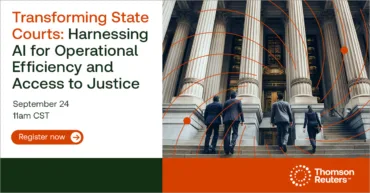Tools and strategies for enhancing security, identity verification, and operational integrity
Many perceive correction agencies and institutions as having a straightforward task: securely supervising convicted individuals according to court sentences. However, their mission is far more complex. Large federal corrections systems and smaller state and local facilities perform a variety of complex functions, each presenting unique challenges. These include maintaining the safety and well-being of incarcerated individuals and facilitating their eventual re-entry into society.
Advanced investigative platforms like CLEAR serve as critical force multipliers in modern correctional operations. By delivering access to expansive public records and proprietary intelligence, CLEAR empowers corrections personnel and investigators with the insight necessary to drive swift, informed action. It uncovers hidden associations, expedites investigations, and enables targeted interventions such as addressing fraud-related crimes.
This operational advantage is magnified through strategic collaborations, most notably with LEO Technologies. Their next-generation investigative tool integrates with authorized inmate communications systems, analyzing vast volumes of call data to uncover actionable information ranging from fraud and identity theft to the orchestration of illicit networks. Enhancing correctional facility security, the Verus system delivers near-real-time information to empower public safety agencies to proactively detect threats, disrupt illicit activity, and intervene swiftly in situations impacting staff or inmate safety.
Verus by LeoTech’s investigative platform uses AI technology to identify call data related to correctional facility safety and security. Verus is a versatile, user-friendly platform designed for correctional use, supporting mental health intervention, contraband detection, and identifying threats tied to broader community safety priorities.
Together, CLEAR and LEO Technologies enable agencies to operate with heightened coordination and precision in safeguarding facilities and communities with intelligence-led enforcement strategies.
In this piece, we delve into these evolving threats within Departments of Corrections (DOCs) and examine how these organizations are developing effective responses to safeguard their populations and enhance their operational integrity.
Jump to ↓
| The risk of fraud within DOCs |
| The evolving challenge of ID verification |
| Other types of fraud flourishing |
The risk of fraud within DOCs
Corrections agencies share some of the same risk and fraud exposure, such as identity theft, embezzlement, cybersecurity threats, and corrupt practices of staff, as other government agencies do. However, in the case of DOCs, this fraud comes at the expense of inmates or the facility, and often, the threat is not just financial loss but security breaches as well.
Departments of corrections (DOCs) integrate into the larger economy and intersect with the adjacent sectors that combat evolving risks and fraud. These sectors include healthcare systems, commercial vendors, social service contract agencies, specialized staffing providers, and information services. Responding effectively within the corrections system requires staff to be alert and up to date with new fraud methods. Management must also ensure that new staff and contractors receive training on a heightened level of risk and fraud awareness.
Fortunately, there are tools available to address these challenges. For instance, contraband trafficking in prison systems often involves staff. However, with technology like CLEAR, auditors and investigators can access criminal records to identify prior contraband trafficking charges in potential new hires, thereby minimizing the risk of such crimes occurring.
Government agencies are pushing to deliver seamless and timely digital access to resources for both internal and public use due to the rise in digital crimes. They are rapidly implementing AI tools in the public sector, and designing a risk management plan that leverages AI’s strengths—such as detecting anomalous patterns and flagging discrepancies—is crucial for effectively deploying fraud-fighting technologies. Platforms that provide real-time access to critical data equip corrections agencies with the most current information for effective identity verification and fraud prevention.
The evolving challenge of ID verification
Consider the crucial problem of identity verification with DOCs. A corrections agency must accurately identify individuals under their supervision or custody and confirm the identities of service providers such as healthcare, transportation, meals, drug testing, and counseling. Additionally, regular staff hiring within the agency requires sharp attention to understanding a potential staffer’s background and their social networks.
Authorities often link human rights abuses and corruption indictments in prisons, both globally and in the United States, to previous failures to properly vetting staff and contractors. Failure to properly screen personnel and contractor staff at New York City’s large jail facility, Rikers Island, contributed to serious failures in the adequate provision of healthcare services for highly vulnerable inmates, as well as enabling an extensive contraband network to flourish.
The 2025 Rikers Island incident exemplifies fraud, where individuals allegedly feigned injuries from on-duty incidents to claim workers’ compensation benefits. Such corruption highlights a larger issue concerning the integrity of law enforcement and the public’s trust. By utilizing new technology like CLEAR, Departments of Corrections can enhance their focus on resources and programs within the organization to help prevent similar incidents.
Other types of fraud flourishing
Despite the importance of fighting identity fraud, there are several other types of fraudulent activity that plague DOCs, including:
Phishing — Even the most vigilant corrections personnel are not immune from the increasingly sophisticated forms of so-called phishing scams that seek to steal and re-deploy login credentials and identity documents. Government platforms for verification are now easily mimicked. In fact, it has been demonstrated how realistic recent fraudulent impersonations have become according to other familiar identity verification platforms.
Disappearing acts — Corrections agencies need efficient ways to keep tabs on those who are under more relaxed supervision than in a jail or prison, including halfway houses, court-mandated treatment centers, parole, and probation. The new generation of people-finding databases improves the ability to locate individuals who abscond from these settings. It achieves this by combining traditional records like Social Security numbers and drivers’ licenses with consumer and credit data, social media scans, and other unconventional digital traces of everyday activities. It isn’t necessary for corrections agencies to reinvent the wheel: they can use many of the same modern tools used by skip tracers, investigators who find elusive debtors. Additionally, incorporating the License Plate Recognition feature in CLEAR offers a valuable method to locate and keep track of individuals, further enhancing these efforts.
Impersonation — Agencies can also prevent digital impersonation by screening quickly at the application stage, with comprehensive identity verification solutions that go beyond collecting documents, raising red flags much earlier in the process. Impersonation is nothing new in correction systems, but identity fraud in the digital age is becoming more sophisticated. DOCs need an efficient way to detect and deter illicit actors when they approach correctional institutions as potential employees, vendors, or contractors. In the worst-case scenario, fraudulent credentials may allow service providers and staff who are intent on aiding criminal activity into the facility. The strategic use of technology, including solutions like CLEAR, can enhance identity verification and help prevent digital impersonation. By providing comprehensive identity verification solutions, CLEAR raises red flags earlier in the process, improving security and trust.
Corrections agencies, in order to gain efficiency and prevent problems, need budget-conscious solutions that address their unique challenges in preventing fraud and malfeasance.
Explore the benefits of advanced technology solutions like Thomson Reuters CLEAR to protect government resources and enhance the efficiency of corrections operations.

CLEAR
Prevent fraud, detect risk, and investigate crime with powerful online investigation software
Get Started ↗
Disclaimer
Thomson Reuters is not a consumer reporting agency, and none of its services or the data contained therein constitute a ‘consumer report’ as such term is defined in the Federal Fair Credit Reporting Act (FCRA), 15 U.S.C. sec. 1681 et seq. The data provided to you may not be used as a factor in consumer debt collection decisioning, establishing a consumer’s eligibility for credit, insurance, employment, government benefits, or housing, or for any other purpose authorized under the FCRA. By accessing one of our services, you agree not to use the service or data for any purpose authorized under the FCRA or in relation to taking an adverse action relating to a consumer application.















